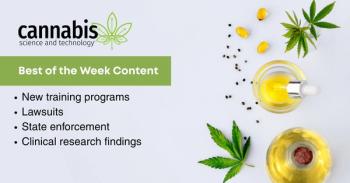
Cannabis Science and Technology
- June 2021
- Volume 4
- Issue 5
Dispelling Cannabis Analysis Myths, Part I

A number of misconceptions people have about how to test, what to test, and when to test in the cannabis industry are dispelled.
The analysis of legal cannabis is a new field, and not surprisingly beset with growing pains. As a result, misconceptions exist about how to test, what to test, and when to test. In this column, I will put my PhD and 40+ years of analytical chemistry experience to work to dispel several of these myths. This matters because these misconceptions are preventing the industry from meeting its full potential.
One of the challenges in the legal cannabis industry is the newness of it all. Regulations are constantly changing, and many people with no previous experience in the manufacture of medicines—and yes everyone in this business is somehow involved in the production of cannabis-based medicines—are entering the business. When it comes to cannabis analysis, these newbies may easily succumb to myths and half-truths peddled by some of the less scrupulous members of our business community. My goal in this column is to dispel some of those myths to help the cannabis analysis community make informed decisions about what analyzers to buy and how to properly use them. Here is the first of
seven myths.
Accuracy at All Costs
As discussed in a previous column, accuracy is how far an analysis is from its true value (1). Given the importance of accuracy, it is not uncommon for people to demand all cannabis analyses have the maximum amount of accuracy that is technically possible. The problem here is that accuracy comes at a cost. For example, liquid chromatography–mass spectrometry (LC–MS) systems can accurately determine pesticide amounts in samples with an accuracy in the parts-per-billion (ppb) range. These instruments cost hundreds of thousands of dollars. Whereas if you wanted to measure the potency of a marijuana bud, I doubt ppb accuracy for the determination of total tetrahydrocannabinol (THC) is needed to optimize growing conditions or determine when to harvest. Probably an error bar of ±1 weight percent (wt.%) may be needed to make rational business decisions. The chromatographs (2) and spectrometers (3) used to measure potency in cannabis samples cost tens of thousands of dollars, not hundreds of thousands of dollars. In this example, the obsession with accuracy at all costs might prompt you to buy a potency analyzer that costs hundreds of thousands of dollars, when an analyzer a fraction of this cost may be sufficient.
The morale of this story is that the accuracy to demand of your cannabis analyzer is determined not by the maximum accuracy available, but by the needs of your business. You need to think about how you will use the data it generates, what kinds of decisions will be made based on that data, and then use this information to determine the needed accuracy. Lastly, as I have pointed out in previous columns (1,2) in addition to accuracy, speed, and cost, the ability to readily perform representative sampling should be used to evaluate cannabis analyzers.
Accuracy at Little Cost
On the other hand, there are companies peddling cannabis potency analyzers that claim to accurately determine cannabinoids and terpenes with high accuracy at a cost of around $1000 or less. Many of these systems work off a cell phone and need an internet connection to the cloud to work. My first concern here is data security—your company’s proprietary sample data is being sent over the internet, via a connection of who knows what security, to a server somewhere in the cloud where the weight percents are mysteriously generated and downloaded to your phone. Many of these companies claim high accuracy but refuse to disclose what their algorithms are, how they work, or how they calibrate and validate their units. I know because I have called these companies, talked to their chief technical officers, and they have absolutely refused to discuss how their systems work. This is not how science works folks—we have to show our work to be taken seriously.
My other criticism here is of their accuracy claims. Some claim to be able to accurately determine total THC in hemp at the 0.3% total THC legal limit as legislated here in the US. This requires a margin of error of 0.05% or better to confidently determine legality. In any other field of chemical analysis I have never seen an analyzer capable of second decimal place accuracy at a cost of $1000. Why is it then it is only in cannabis analysis that these miraculous $1000 devices capable of second decimal place accuracy are found? And where is the peer-reviewed data backing up your accuracy claims? Nowhere to be found of course.
The morale of the story here is that you get what you pay for. If you only need ±10% accuracy an inexpensive analyzer may work fine. But if you need anything better than this it is going to cost you tens of thousands of dollars or more. This is simply the state of analytical technology in 2021.
We Don’t Need No Stinking Testing!
If I had a dime for every time I have heard this myth I would be a rich man. It appears the thought here is that since governments only require final products to be tested before sale, that this is the only testing that needs to be performed and that in-house testing is not needed. This is wrong on so many levels it is hard to know where to start. I am constantly using this column to point out that cannabis businesses make medicines and hence should test like they are making medicines. That is, “Cannabis is Medicine…Test it Like Medicine,” which as I have stated previously was almost the title for this column series (4). My goal for the cannabis industry is for us to adopt the pharmaceutical testing paradigm, which means cradle-to-grave testing (4). This means whether you are growing, extracting, or formulating final products you need to be testing at every step in your process and testing your final products as well. Here is why:
- Quality control—You cannot make any chemical product reproducibly without testing. You can’t do the same thing twice if you don’t what you did or how you did it. A definition of quality is being able to reproduce your process and product on a consistent basis. This will never happen without in-house testing.
- Business knowledge—You cannot make cannabis products profitably unless you optimize your grow, extraction, formulation, and so forth. And you cannot do this without in-house testing. For example, I have seen extractors increase oil yield by upwards of 20% by optimizing their extractions and distillations by using in-house analyzers. In many cases, the payback period here is only a few weeks. I have seen hemp farmers use in-house analyzers to pick the right harvest time where the total cannabidiol (CBD) is maximized but the total THC level is still legal to get the best price for their crop. In-house testing is the profitable thing to do.
- Customer safety—Almost all cannabis products end up going into or onto a human being. Thus, we have a legal and moral obligation to make sure our products are safe. Not surprisingly, killing or injuring customers is bad for business. We cannot make cannabis products that are safe and effective unless we know what we are making and how we make it. The only route to this goal is in-house testing.
We Only Need to Test During Process Development
I run across this myth particularly with extractors and processors. The thought here is that once all the temperatures, times, amounts, and so forth for an extraction are optimized no further testing is needed. Hence, you only need to rent an analyzer for a few weeks, optimize the process, and then give it back to save money. The problem here is that something may always go wrong with a chemical process such as an extraction or distillation, so you need to test every batch you make not just during product development.
A further problem is that physical variables such as temperature and pressure are stand-ins for what we truly care about, the chemical composition of the product we are actually making. It is thus best to test the chemical composition of the product, rather than stuff that might be related to it.
A final problem here is that the definition of quality control is monitoring your process every time and in real time. By not monitoring chemical composition this way you leave yourself open to making bad batches that may need to be scrapped, or worse yet letting bad product go out the door for sale that may harm people.
One Analyzer to Rule Them All
I have found end users using cannabis analyzers to test paper, food, or most anything else they can get their hands on, and then claim their cannabis analyzer “sucks” because it “found cannabinoids in samples I know don’t contain them.” The problem here is that analyzers can only accurately analyze that for which they have been calibrated. Cannabis analyzers are not typically designed to analyze anything else. When used to analyze non-cannabis samples a cannabis analyzer may produce results, but they will be meaningless. Some people expect their new fangled cannabis analyzer to be smart enough to know when it is presented with a cannabis sample and when it isn’t. As I like to say in these situations, the tricorder will not be invented for another 300 years (5) and there is not one analyzer that can analyze everything.
There are millions of possible samples one can try to study with a cannabis analyzer. I am afraid science does not yet know how to discriminate 100% of the time between cannabis and non-cannabis samples. In the meantime, please only use your analyzer for the samples it is designed to work on.
“It’s a Plant, Not Plutonium”
I hear this said in the cannabis and nutraceutical industries. The thought here is since cannabis products are derived from all natural plant material that anything derived from it is innocuous and harmless and that minimal or no testing is needed in our industry. In fact, nothing could be further from the truth. For example, moldy cannabis upon extraction can yield aflatoxins which are known poisons, carcinogens, and mutagens (6). The reason we test biomass for mold is to prevent this. So much for natural things being safe.
I Trust My Vendor
Adulteration, lying, and counterfeiting takes place in every industry and the cannabis industry is no exception. For example, I had a hemp extractor customer who took his hemp analyzer to a farmer to purchase biomass. The farmer trotted out a certificate of analysis (COA) saying the total CBD value was 14.6%. An on the spot test with the analyzer showed 9.2% total CBD. The farmer then said, “I am sorry, I gave you the wrong COA,” and he trotted one out that said 9.2% total CBD. By performing an onsite test the extractor saved tens of thousands of dollars by not paying for CBD that wasn’t there.
Regardless of the relationship you may have with your vendors, people make mistakes either intentionally or unintentionally, by not testing what you are buying it can cause great damage to your business. Given this, I believe every cannabis industry transaction should feature an on the spot test with a potency analyzer to insure people are getting what they pay for. As an old Russian proverb says, “Trust, but verify” (7).
Conclusion
There are a number of dangerous cannabis analysis myths floating around our industry. Using science and my own experience, I have tried to dispel these myths.
References
- B.C. Smith, Cannabis Science and Technology 1(4), 12-16 (2018).
- M.W. Giese, M.A. Lewis, L. Giese, and K.M. Smith, Journal of AOAC International 98(6), 1503 (2015).
- B.C. Smith and C. Fucetola, Cannabis Science and Technology 3(6), 24–38 (2020).
- B.C. Smith, Cannabis Science and Technology, 2(4), 12–14 (2019).
Tricorder - Wikipedia , https://en.wikipedia.org/wiki/Tricorder.Aflatoxin - Wikipedia , https://en.wikipedia.org/wiki/Aflatoxin.Trust, but verify - Wikipedia , https://en.wikipedia.org/wiki/Trust,_but_verify.
About the Columnist
Brian C. SMITH, PHD, is Founder, CEO, and Chief Technical Officer of Big Sur Scientific. He is the inventor of the BSS series of patented mid-infrared based cannabis analyzers. Dr. Smith has done pioneering research and published numerous peer-reviewed papers on the application of mid-infrared spectroscopy to cannabis analysis, and sits on the editorial board of Cannabis Science and Technology. He has worked as a laboratory director for a cannabis extractor, as an analytical chemist for Waters Associates and PerkinElmer, and as an analytical instrument salesperson. He has more than 30 years of experience in chemical analysis and has written three books on the subject. Dr. Smith earned his PhD on physical chemistry from Dartmouth College. Direct correspondence to:
How to Cite this Article
B. Smith, Cannabis Science and Technology 4(5), 10-12 (2021).
Articles in this issue
over 4 years ago
Hemp Regulations and the Restrictions on Innovationover 4 years ago
Is Carbon-Neutral Cannabis Possible?over 4 years ago
Analytical Techniques Used for Analysis of CannabinoidsNewsletter
Unlock the latest breakthroughs in cannabis science—subscribe now to get expert insights, research, and industry updates delivered to your inbox.



